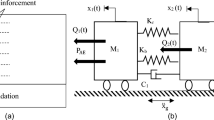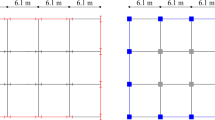Abstract
This paper describes the seismic retrofit of masonry structures by introducing some steel moment resisting frames within the buildings. The intent is not to improve the seismic performance of masonry structures but to present protective steel shells within the structures that provide protection from loss of life. The main idea is that occupants can seek refuge within the steel frames as soon as the earthquake ground motions are felt. The steel frames do not carry any service loads before an earthquake. However, if a near field seismic event happens and the load bearing walls of the buildings are destroyed, some parts of their floors, which are in the retrofitted areas, will fall on the roof of the installed frames; consequently, the occupants who have sheltered in these areas will survive. This paper expresses the experimental work to assess the seismic performance of moment resisting steel frames in masonry buildings, and also it compares the test results with those obtained from linear time history and nonlinear pushover analyses. For time history analysis, the 1940 El Centro, 2003 Bam, and 1990 Manjil earthquake records scaled at the maximum peak ground acceleration assumed by the Iranian Technical Standards, equal to 0.35 g, were utilized as inputs. The results of experimental work, time history and pushover analyses show that the strength and displacement capacity of the steel frames are adequate to accommodate the distortions generated by seismic loads and aftershocks.
Similar content being viewed by others
References
Ahmadizadeh, M. and Shakib, H. (2004). “On the December 26, 2003, southeastern Iran earthquake in Bam region.” Engineering Structures, Vol. 26, pp. 1055–1070.
Al-Saidy, A. H., Klaiber, F. W., and Wipf, T. J. (2007), “Strengthening of steel-concrete composite girders using carbon fiber reinforced polymer plates.” Construction and Building Materials, Vol. 21, pp. 295–302.
Baker, J. F., Horne, M. R., and Heyman, J. (1956). The steel skeleton, Volume II, Plastic Behaviour and Design, The Cambridge University Press.
Fajfar, P. and Fischinger, M. (1988). “N2 — A method for non-linear seismic analysis of regular structures.” 9 th World Conference of Earthquake Engineering, Vol. 5, Tokyo-Kyoto, Japan, pp. 111–116.
Fajfar, P. and Krawinkler, H. (1992). Nonlinear seismic analysis and design of reinforced concrete buildings, Elsevier, London.
FEMA (1996). NEHRP guidelines for the seismic rehabilitation of buildings, FEMA 273, Federal Emergency Management Agency.
Krawinkler, H. and Rahnama, M. (1992). “Effects of soft soils on design spectra.” 10th World Conference on Earthquake Engineering, Vol. 10, Madrid, Spain, pp. 5841–5846.
Krawinkler, H. and Seneviratna, G. D. P. K. (1998). “Pros and cons of a pushover analysis for seismic performance evaluation.” Engineering Structures, Vol. 20, Nos. 4–6, pp. 452–464.
Lawson, R. S., Vance, V., and Krawinkler, H. (1994). “Nonlinear static pushover analysis — Why, when and how?” 5 th US Conference of Earthquake Engineering, Vol. 1, Chicago, IL, pp. 283–292.
Maheri, M. R. and Rahmani, H. (2003). “Static and seismic design of one-way and two-way jack arch masonry slabs.” Engineering Structures, Vol. 25, pp. 1639–1654.
Mazloom, M. and Mehrabian, A. A. (2006). “A new method for reducing earthquake casualties in poor performance masonry buildings.” International Journal of Civil Engineering, Vol. 4, No. 4, pp. 330–341.
Mazloom, M. and Mehrabian, A. A. (2009). “Pullback test for seismic performance evaluation of safe rooms.” International Journal of Civil Engineering, Vol. 7, No. 4, pp. 280–288.
Miranda, E. (1991). Seismic evaluation and upgrading of existing buildings, PhD Dissertation, Department of Civil Engineering, University of California, Berkley, CA.
Miranda, E. and Bertero, V. V. (1994). “Evaluation of strength reduction factors for earthquake-resistant design.” Earthquake Spectra, EERI, Vol. 10, No. 2, pp. 357–379.
Nassar, A. A. and Krawinkler, H. (1991). Seismic demands for SDOF and MDOF systems, John A. Blume Earthquake Engineering Center, Report No. 95, Department of Civil Engineering, Stanford University.
Nassar, A. A., Krawinkler, H., and Osteraas, J. D. (1992). “Seismic design based on strength and ductility demands.” 10th World Conference on Earthquake Engineering, Vol. 10, Madrid, Spain, pp. 5861–5866.
Neville, A. M., and Brooks, J. J. (1990). Concrete technology, Longman, United Kingdom.
Newmark, N. M. and Hall, W. J. (1982). Earthquake spectra and design, EERI Monograph Series.
Rahnama, M. and Krawinkler, H. (1993). Effects of soft soils and hysteresis models on seismic design spectra, John A. Blume Earthquake Engineering Center, Report No. 107, Department of Civil Engineering, Stanford University.
Standard No. 2800-05 (2005). Iranian code of practice for seismic resistant design of buildings, 3rd Edition, Building and Housing Research Center, PN S 253.
Vidic, T., Fajfar, P., and Fischinger, M. (1994). “Consistent inelastic design spectra: Strength and displacement.” Earthquake Engineering and Structural Dynamics, Vol. 2.
Author information
Authors and Affiliations
Corresponding author
Rights and permissions
About this article
Cite this article
Mazloom, M. Incorporation of steel frames in masonry buildings for reduction of earthquake-induced life loss. KSCE J Civ Eng 17, 736–745 (2013). https://doi.org/10.1007/s12205-013-0085-7
Received:
Revised:
Accepted:
Published:
Issue Date:
DOI: https://doi.org/10.1007/s12205-013-0085-7




